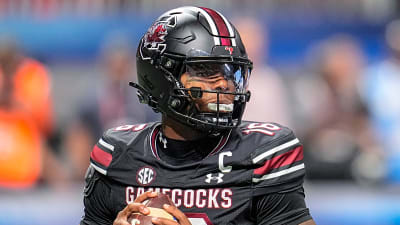
When the Detroit Red Wings acquired goaltender John Gibson from the Anaheim Ducks, the former all-star provided the organization with something they haven’t had in several years – stability in net. Gibson, 31, is under contract through 2027, and still has plenty left in the tank.
Given Detroit’s recent revolving door of goalies, we’ve learned that performance and stats don’t always translate one-for-one when these netminders switch teams. Some look better in Detroit; some look worse. The situation-to-situation context is important when trying to project what a goalie will bring to the Red Wings.
That’s exactly what we’re going to do today – explore what Gibson can bring to the organization. Let’s dive in.
Gibson Moving From Anaheim to Detroit
First, we’ll take a look at some key metrics to evaluate what Gibson can expect when he’s in net for the Red Wings. We’ll use 2024-25 numbers since Detroit’s year-over-year changes aren’t too great.
| Anaheim Ducks | Metric | Detroit Red Wings |
| 66.73 | CA/60 | 59.94 |
| 13.18 | HDCA/60 | 11.40 |
| 18.15 | Blocked Shots/60 | 16.98 |
Note: The numbers above are in all situations and are the 2024-25 average for each team.
On average, the Ducks gave up seven more shot attempts and almost two more high-danger chances against per 60 compared to the Red Wings. Anaheim did block about one more shot per 60, but the Red Wings blocked a slightly greater percentage of shot attempts (28.3 percent to 27.2 percent).
If the Red Wings maintain the same pace in 2025-26, then Gibson will be in a somewhat more favorable situation than he was in Anaheim. In addition, one of Detroit’s organizational goals is to be better defensively in 2025-26, but it’s unclear if that will come to fruition as of now.
Given this, it’s reasonable to suggest that Gibson could produce similar numbers as he did last season—2.77 GAA and .912 SV%—in a modestly improved environment. That said, the netminder only suited up for 29 games in 2024-25. His numbers could have shifted in either direction if he was able to start more games for the Ducks.
Optimal Red Wings Workload for Gibson
The last point above brings us to a question – how should the Red Wings handle starting duties between Gibson and 38-year-old Cam Talbot. The latter was adequate for Detroit last year and is in outstanding shape. Still, there’s plenty of risk in the crease given Gibson’s injury history and Talbot’s age.
Over the last four years, Gibson has started 180 out of a possible 328 games for the Ducks. That averages out to 45 starts per season. However, he started only 28 games in 2024-25, first sidelined by an appendectomy that cost him 13 games, then hampered by additional injuries later on that limited him to just three appearances over the final 21 contests.
It should also be noted that Gibson’s 2024-25 campaign was his best since 2018-19, statistically speaking. With that in mind, it’s fair to say that his optimal workload lies somewhere between his four-year average and last year’s 28 starts.
Talbot, on the other hand, started 43 games for the Red Wings in 2024-25 and appeared in four others. Since 2021-22, he has averaged 43.75 starts per year across four teams.
What might be most beneficial for everyone involved would be a true 50-50 split between Gibson and Talbot. Detroit should aim to give both about 40 starts, give or take a few based on injuries, scheduling quirks, and hot streaks, plus Sebastian Cossa getting a couple spot starts. In this scenario, Gibson and Talbot would get ample rest to recover and avoid some of the wear and tear that occurs every season.
Final Word
If Gibson starts roughly 40 games for the Red Wings, he could put together one of Detroit’s better goaltending campaigns in recent years. The talent is there – he just needs to stay healthy. And limiting his workload to that amount should help him do just that.
Surely, Red Wings fans were hoping for a workhorse when the team acquired Gibson, and I can understand frustration in more of a 1A/1B setup. It’s about playing the long game, though. They’ll need both goalies throughout the year – getting them through it unscathed will greatly improve Detroit’s chances of making the playoffs. A timeshare is the best way to do that.
Data courtesy of NHL.com and Natural Stat Trick.
More must-reads:
- Five biggest disappointments from first month of NHL season
- Five biggest surprises from first month of NHL season
- The 'TDs from Josh Allen or Patrick Mahomes' quiz
Breaking News
Trending News
Customize Your Newsletter
 +
+
Get the latest news and rumors, customized to your favorite sports and teams. Emailed daily. Always free!








